Marketing Fundamentals: Coca-Cola Amatil Analysis and Strategies
VerifiedAdded on 2020/04/13
|11
|2960
|86
Report
AI Summary
This report examines the marketing fundamentals of Coca-Cola Amatil (CCA), a major beverage company. It begins with an introduction and background of the company, outlining its operations across the Asia Pacific region. The report then conducts a situation analysis, including PESTLE and SWOT analyses to assess the external and internal environments, respectively. Competitive analysis focuses on key rivals like PepsiCo and Nudie Foods Australia, evaluating their marketing mixes. The report also explores consumer buyer characteristics, such as information search and brand loyalty, and their impact on purchasing behavior. Finally, the report concludes by summarizing the key findings and highlighting CCA's strategies for maintaining a competitive advantage in the global market. The report emphasizes the importance of marketing mix, consumer behavior, and strategic analysis in the success of the company. It provides a comprehensive overview of CCA's market position, challenges, and opportunities.
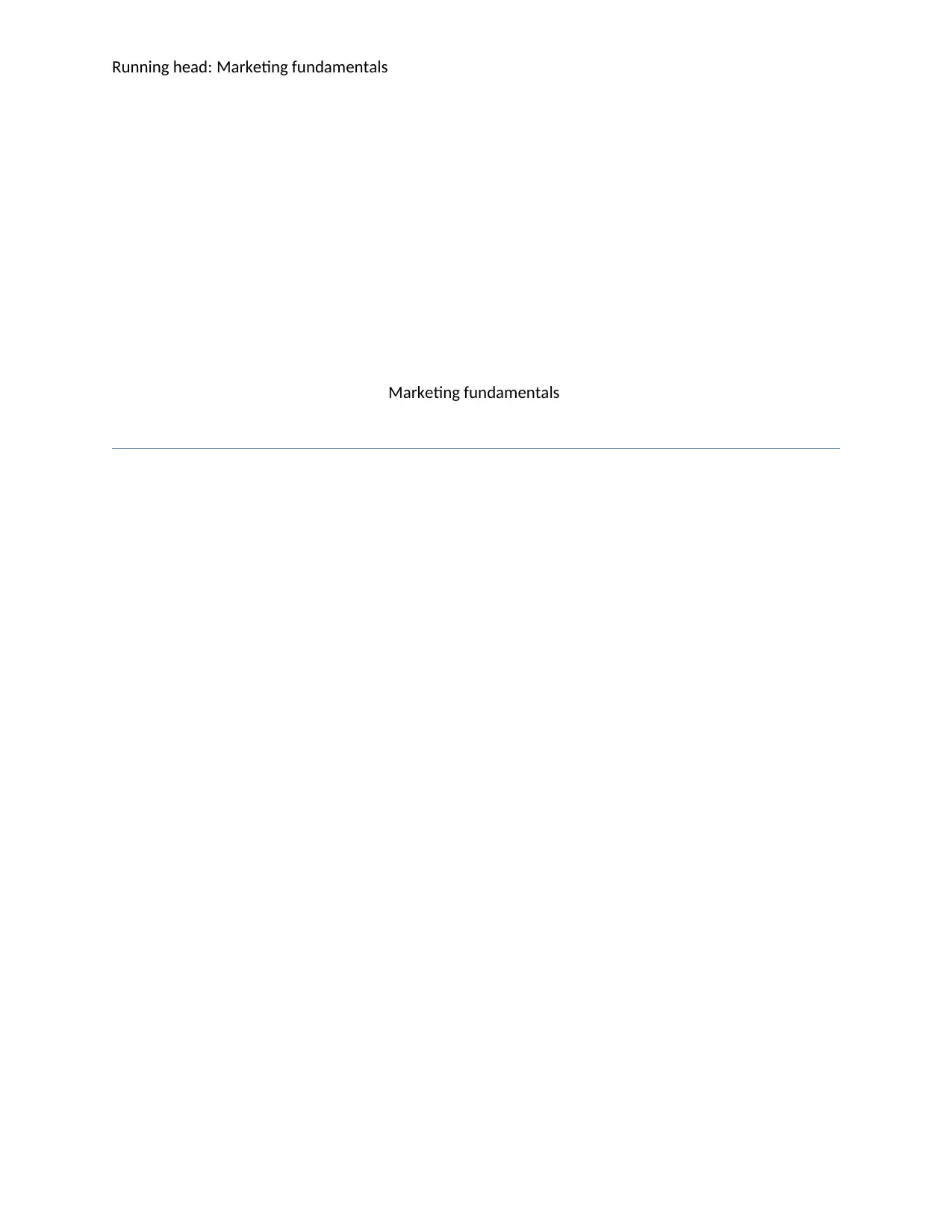
Running head: Marketing fundamentals
Marketing fundamentals
Marketing fundamentals
Paraphrase This Document
Need a fresh take? Get an instant paraphrase of this document with our AI Paraphraser
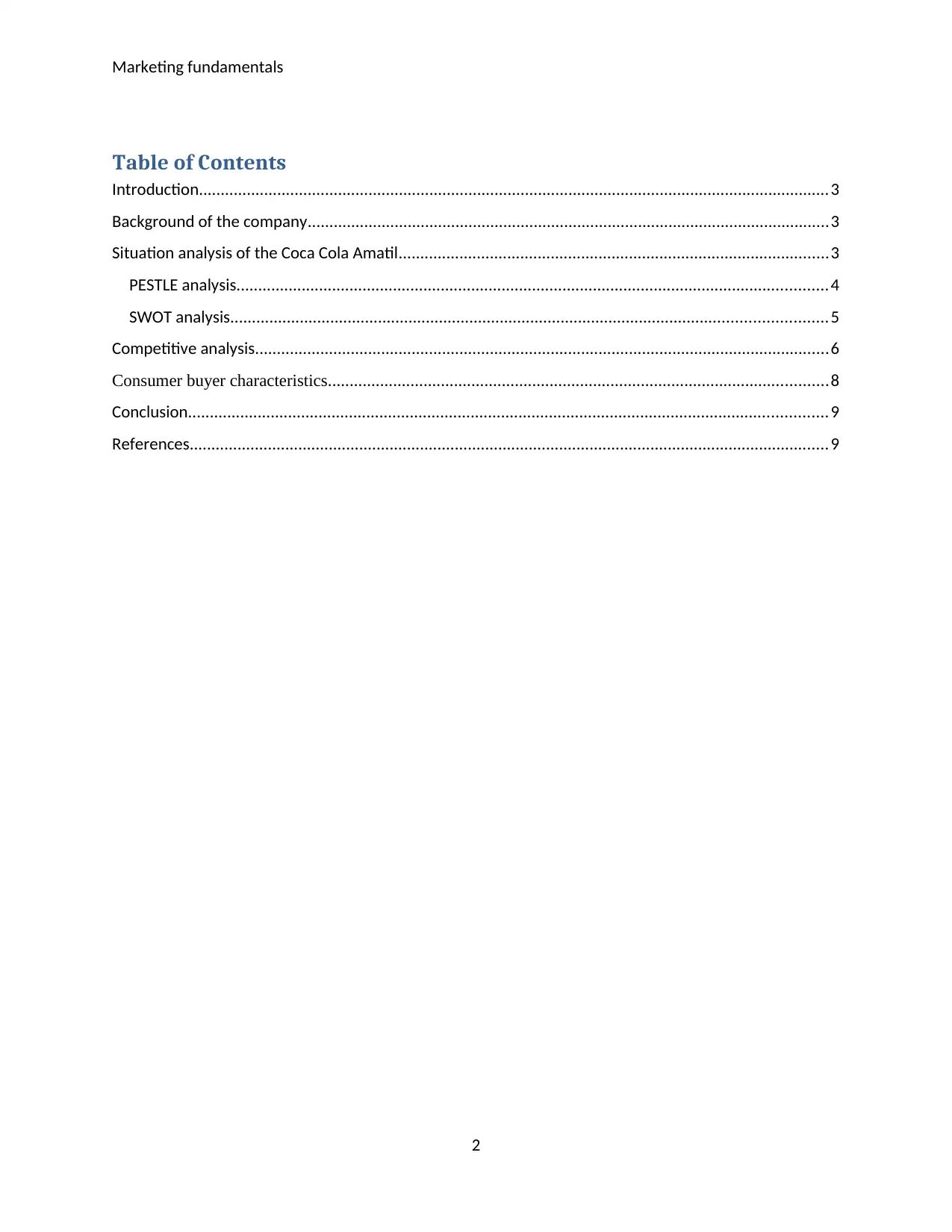
Marketing fundamentals
Table of Contents
Introduction.................................................................................................................................................3
Background of the company........................................................................................................................3
Situation analysis of the Coca Cola Amatil...................................................................................................3
PESTLE analysis........................................................................................................................................4
SWOT analysis.........................................................................................................................................5
Competitive analysis....................................................................................................................................6
Consumer buyer characteristics...................................................................................................................8
Conclusion...................................................................................................................................................9
References...................................................................................................................................................9
2
Table of Contents
Introduction.................................................................................................................................................3
Background of the company........................................................................................................................3
Situation analysis of the Coca Cola Amatil...................................................................................................3
PESTLE analysis........................................................................................................................................4
SWOT analysis.........................................................................................................................................5
Competitive analysis....................................................................................................................................6
Consumer buyer characteristics...................................................................................................................8
Conclusion...................................................................................................................................................9
References...................................................................................................................................................9
2
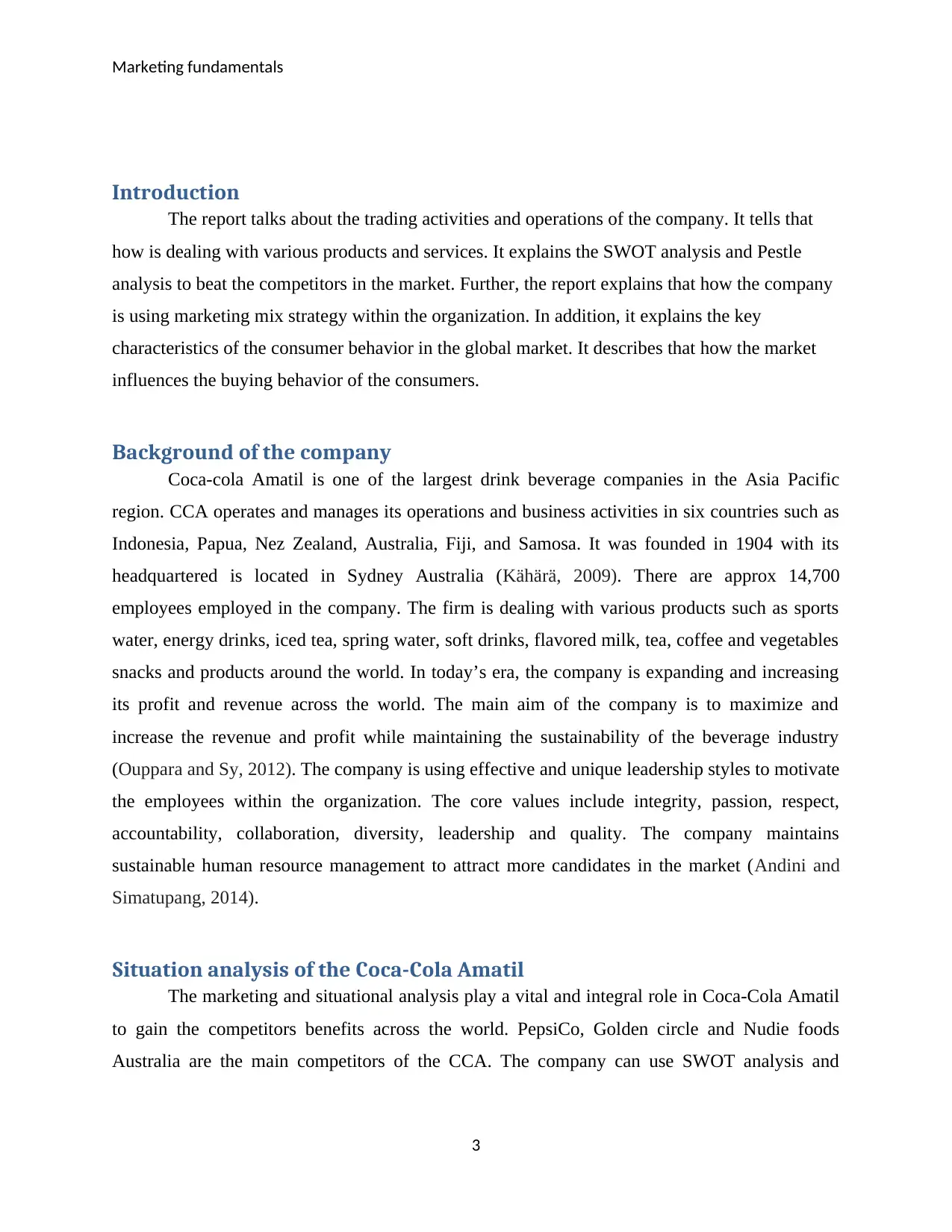
Marketing fundamentals
Introduction
The report talks about the trading activities and operations of the company. It tells that
how is dealing with various products and services. It explains the SWOT analysis and Pestle
analysis to beat the competitors in the market. Further, the report explains that how the company
is using marketing mix strategy within the organization. In addition, it explains the key
characteristics of the consumer behavior in the global market. It describes that how the market
influences the buying behavior of the consumers.
Background of the company
Coca-cola Amatil is one of the largest drink beverage companies in the Asia Pacific
region. CCA operates and manages its operations and business activities in six countries such as
Indonesia, Papua, Nez Zealand, Australia, Fiji, and Samosa. It was founded in 1904 with its
headquartered is located in Sydney Australia (Kähärä, 2009). There are approx 14,700
employees employed in the company. The firm is dealing with various products such as sports
water, energy drinks, iced tea, spring water, soft drinks, flavored milk, tea, coffee and vegetables
snacks and products around the world. In today’s era, the company is expanding and increasing
its profit and revenue across the world. The main aim of the company is to maximize and
increase the revenue and profit while maintaining the sustainability of the beverage industry
(Ouppara and Sy, 2012). The company is using effective and unique leadership styles to motivate
the employees within the organization. The core values include integrity, passion, respect,
accountability, collaboration, diversity, leadership and quality. The company maintains
sustainable human resource management to attract more candidates in the market (Andini and
Simatupang, 2014).
Situation analysis of the Coca-Cola Amatil
The marketing and situational analysis play a vital and integral role in Coca-Cola Amatil
to gain the competitors benefits across the world. PepsiCo, Golden circle and Nudie foods
Australia are the main competitors of the CCA. The company can use SWOT analysis and
3
Introduction
The report talks about the trading activities and operations of the company. It tells that
how is dealing with various products and services. It explains the SWOT analysis and Pestle
analysis to beat the competitors in the market. Further, the report explains that how the company
is using marketing mix strategy within the organization. In addition, it explains the key
characteristics of the consumer behavior in the global market. It describes that how the market
influences the buying behavior of the consumers.
Background of the company
Coca-cola Amatil is one of the largest drink beverage companies in the Asia Pacific
region. CCA operates and manages its operations and business activities in six countries such as
Indonesia, Papua, Nez Zealand, Australia, Fiji, and Samosa. It was founded in 1904 with its
headquartered is located in Sydney Australia (Kähärä, 2009). There are approx 14,700
employees employed in the company. The firm is dealing with various products such as sports
water, energy drinks, iced tea, spring water, soft drinks, flavored milk, tea, coffee and vegetables
snacks and products around the world. In today’s era, the company is expanding and increasing
its profit and revenue across the world. The main aim of the company is to maximize and
increase the revenue and profit while maintaining the sustainability of the beverage industry
(Ouppara and Sy, 2012). The company is using effective and unique leadership styles to motivate
the employees within the organization. The core values include integrity, passion, respect,
accountability, collaboration, diversity, leadership and quality. The company maintains
sustainable human resource management to attract more candidates in the market (Andini and
Simatupang, 2014).
Situation analysis of the Coca-Cola Amatil
The marketing and situational analysis play a vital and integral role in Coca-Cola Amatil
to gain the competitors benefits across the world. PepsiCo, Golden circle and Nudie foods
Australia are the main competitors of the CCA. The company can use SWOT analysis and
3
⊘ This is a preview!⊘
Do you want full access?
Subscribe today to unlock all pages.

Trusted by 1+ million students worldwide
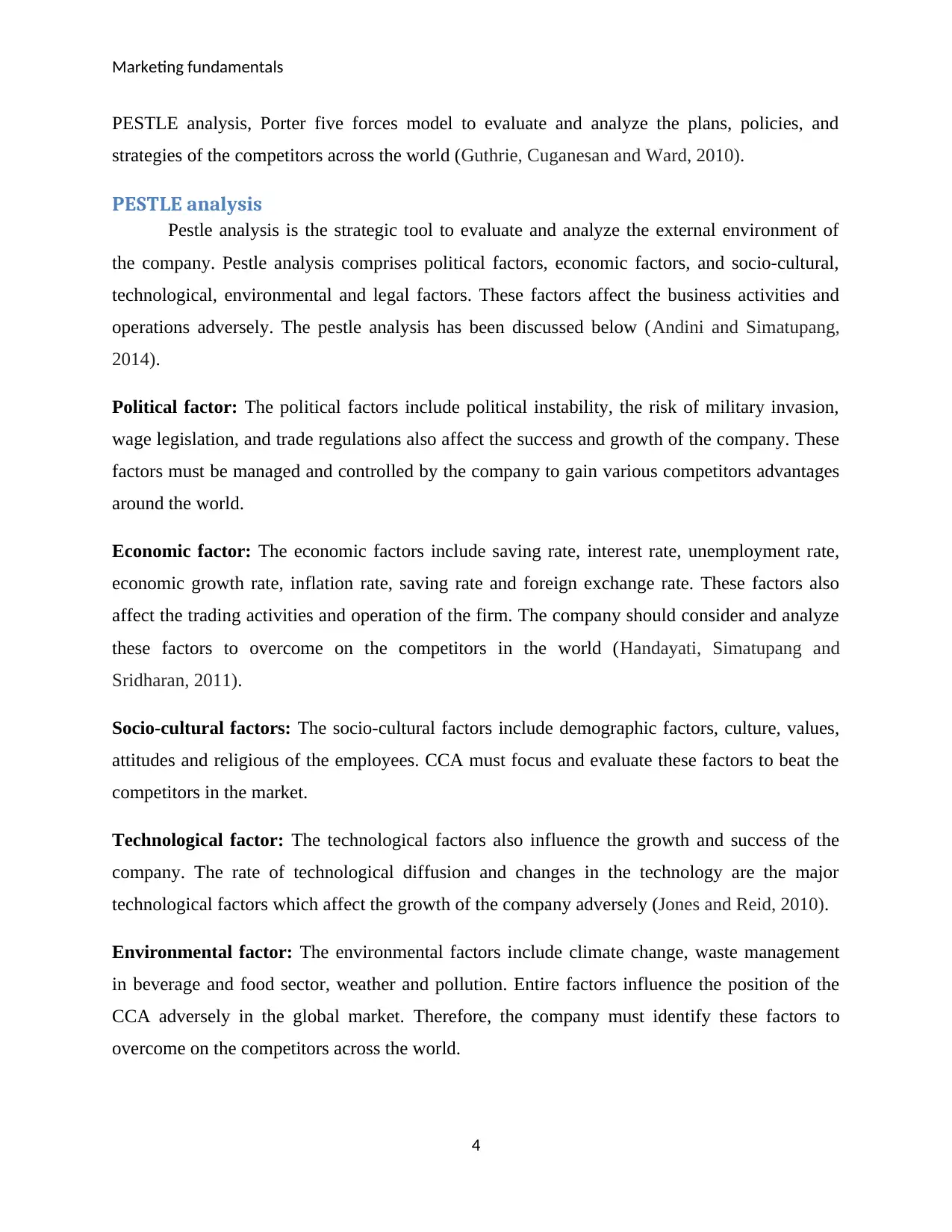
Marketing fundamentals
PESTLE analysis, Porter five forces model to evaluate and analyze the plans, policies, and
strategies of the competitors across the world (Guthrie, Cuganesan and Ward, 2010).
PESTLE analysis
Pestle analysis is the strategic tool to evaluate and analyze the external environment of
the company. Pestle analysis comprises political factors, economic factors, and socio-cultural,
technological, environmental and legal factors. These factors affect the business activities and
operations adversely. The pestle analysis has been discussed below (Andini and Simatupang,
2014).
Political factor: The political factors include political instability, the risk of military invasion,
wage legislation, and trade regulations also affect the success and growth of the company. These
factors must be managed and controlled by the company to gain various competitors advantages
around the world.
Economic factor: The economic factors include saving rate, interest rate, unemployment rate,
economic growth rate, inflation rate, saving rate and foreign exchange rate. These factors also
affect the trading activities and operation of the firm. The company should consider and analyze
these factors to overcome on the competitors in the world (Handayati, Simatupang and
Sridharan, 2011).
Socio-cultural factors: The socio-cultural factors include demographic factors, culture, values,
attitudes and religious of the employees. CCA must focus and evaluate these factors to beat the
competitors in the market.
Technological factor: The technological factors also influence the growth and success of the
company. The rate of technological diffusion and changes in the technology are the major
technological factors which affect the growth of the company adversely (Jones and Reid, 2010).
Environmental factor: The environmental factors include climate change, waste management
in beverage and food sector, weather and pollution. Entire factors influence the position of the
CCA adversely in the global market. Therefore, the company must identify these factors to
overcome on the competitors across the world.
4
PESTLE analysis, Porter five forces model to evaluate and analyze the plans, policies, and
strategies of the competitors across the world (Guthrie, Cuganesan and Ward, 2010).
PESTLE analysis
Pestle analysis is the strategic tool to evaluate and analyze the external environment of
the company. Pestle analysis comprises political factors, economic factors, and socio-cultural,
technological, environmental and legal factors. These factors affect the business activities and
operations adversely. The pestle analysis has been discussed below (Andini and Simatupang,
2014).
Political factor: The political factors include political instability, the risk of military invasion,
wage legislation, and trade regulations also affect the success and growth of the company. These
factors must be managed and controlled by the company to gain various competitors advantages
around the world.
Economic factor: The economic factors include saving rate, interest rate, unemployment rate,
economic growth rate, inflation rate, saving rate and foreign exchange rate. These factors also
affect the trading activities and operation of the firm. The company should consider and analyze
these factors to overcome on the competitors in the world (Handayati, Simatupang and
Sridharan, 2011).
Socio-cultural factors: The socio-cultural factors include demographic factors, culture, values,
attitudes and religious of the employees. CCA must focus and evaluate these factors to beat the
competitors in the market.
Technological factor: The technological factors also influence the growth and success of the
company. The rate of technological diffusion and changes in the technology are the major
technological factors which affect the growth of the company adversely (Jones and Reid, 2010).
Environmental factor: The environmental factors include climate change, waste management
in beverage and food sector, weather and pollution. Entire factors influence the position of the
CCA adversely in the global market. Therefore, the company must identify these factors to
overcome on the competitors across the world.
4
Paraphrase This Document
Need a fresh take? Get an instant paraphrase of this document with our AI Paraphraser
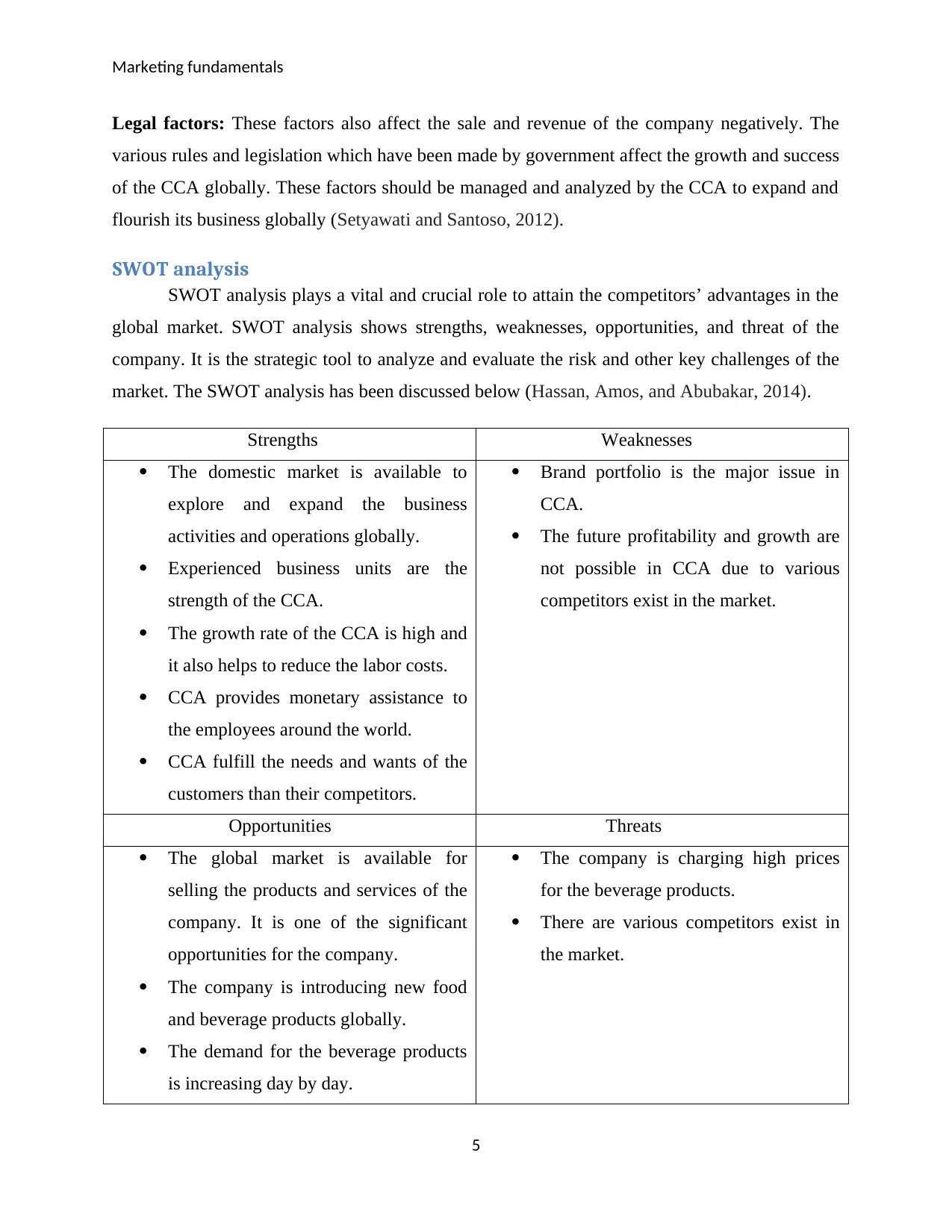
Marketing fundamentals
Legal factors: These factors also affect the sale and revenue of the company negatively. The
various rules and legislation which have been made by government affect the growth and success
of the CCA globally. These factors should be managed and analyzed by the CCA to expand and
flourish its business globally (Setyawati and Santoso, 2012).
SWOT analysis
SWOT analysis plays a vital and crucial role to attain the competitors’ advantages in the
global market. SWOT analysis shows strengths, weaknesses, opportunities, and threat of the
company. It is the strategic tool to analyze and evaluate the risk and other key challenges of the
market. The SWOT analysis has been discussed below (Hassan, Amos, and Abubakar, 2014).
Strengths Weaknesses
The domestic market is available to
explore and expand the business
activities and operations globally.
Experienced business units are the
strength of the CCA.
The growth rate of the CCA is high and
it also helps to reduce the labor costs.
CCA provides monetary assistance to
the employees around the world.
CCA fulfill the needs and wants of the
customers than their competitors.
Brand portfolio is the major issue in
CCA.
The future profitability and growth are
not possible in CCA due to various
competitors exist in the market.
Opportunities Threats
The global market is available for
selling the products and services of the
company. It is one of the significant
opportunities for the company.
The company is introducing new food
and beverage products globally.
The demand for the beverage products
is increasing day by day.
The company is charging high prices
for the beverage products.
There are various competitors exist in
the market.
5
Legal factors: These factors also affect the sale and revenue of the company negatively. The
various rules and legislation which have been made by government affect the growth and success
of the CCA globally. These factors should be managed and analyzed by the CCA to expand and
flourish its business globally (Setyawati and Santoso, 2012).
SWOT analysis
SWOT analysis plays a vital and crucial role to attain the competitors’ advantages in the
global market. SWOT analysis shows strengths, weaknesses, opportunities, and threat of the
company. It is the strategic tool to analyze and evaluate the risk and other key challenges of the
market. The SWOT analysis has been discussed below (Hassan, Amos, and Abubakar, 2014).
Strengths Weaknesses
The domestic market is available to
explore and expand the business
activities and operations globally.
Experienced business units are the
strength of the CCA.
The growth rate of the CCA is high and
it also helps to reduce the labor costs.
CCA provides monetary assistance to
the employees around the world.
CCA fulfill the needs and wants of the
customers than their competitors.
Brand portfolio is the major issue in
CCA.
The future profitability and growth are
not possible in CCA due to various
competitors exist in the market.
Opportunities Threats
The global market is available for
selling the products and services of the
company. It is one of the significant
opportunities for the company.
The company is introducing new food
and beverage products globally.
The demand for the beverage products
is increasing day by day.
The company is charging high prices
for the beverage products.
There are various competitors exist in
the market.
5

Marketing fundamentals
Competitive analysis
PepsiCo and Nudie food Australia are the main competitors of the company. The
marketing mix of the PepsiCo has been discussed below (Assiouras, Ozgen, and Skourtis, 2013).
Product: The PepsiCo is the major competitor of the Coca-Cola Amatil. The PepsiCo is dealing
with various products such as energy drinks, rice snacks, soft drinks and breakfast bars. It uses
product mix strategy to gain the competitive advantages in the market.
Place: The PepsiCo uses the universal network for distributing its products and services to the
customers. The retailers and online merchandisers are the main distribution channels of the
company (Huang and Sarigöllü, 2014).
Promotion: The Company uses various promotion strategies such as direct marketing,
advertising, public relations and sales promotions etc. Advertising is the foremost strategy to
maximize the revenue and profit of the company.
Price: PepsiCo uses pricing strategy to differentiate its products from the Coca-Cola Amatil
products. It uses hybrid value pricing strategy and market-oriented pricing strategy to increase
the sales of the company.
Marketing mix of Nudie
Nudie food Australia is another competitor of the Coca-Cola Amatil. The marketing mix
of the Nudie has been discussed below (Oplatka and Hemsley-Brown, 2012).
Product: The Company is dealing with food and beverage products which include fruits, juice,
ice-cream, and soups. Thus, it affects the activities and operations of the Coca-Cola Amatil
adversely. In this way, the company is becoming successfully day by day.
Place: The Company is making effective and unique strategies to distribute its products and
services in the Australia. The products of the Nudie are sold in more than 6000 outlets in the
Australia (Ryu, Lee and Gon Kim, 2012).
6
Competitive analysis
PepsiCo and Nudie food Australia are the main competitors of the company. The
marketing mix of the PepsiCo has been discussed below (Assiouras, Ozgen, and Skourtis, 2013).
Product: The PepsiCo is the major competitor of the Coca-Cola Amatil. The PepsiCo is dealing
with various products such as energy drinks, rice snacks, soft drinks and breakfast bars. It uses
product mix strategy to gain the competitive advantages in the market.
Place: The PepsiCo uses the universal network for distributing its products and services to the
customers. The retailers and online merchandisers are the main distribution channels of the
company (Huang and Sarigöllü, 2014).
Promotion: The Company uses various promotion strategies such as direct marketing,
advertising, public relations and sales promotions etc. Advertising is the foremost strategy to
maximize the revenue and profit of the company.
Price: PepsiCo uses pricing strategy to differentiate its products from the Coca-Cola Amatil
products. It uses hybrid value pricing strategy and market-oriented pricing strategy to increase
the sales of the company.
Marketing mix of Nudie
Nudie food Australia is another competitor of the Coca-Cola Amatil. The marketing mix
of the Nudie has been discussed below (Oplatka and Hemsley-Brown, 2012).
Product: The Company is dealing with food and beverage products which include fruits, juice,
ice-cream, and soups. Thus, it affects the activities and operations of the Coca-Cola Amatil
adversely. In this way, the company is becoming successfully day by day.
Place: The Company is making effective and unique strategies to distribute its products and
services in the Australia. The products of the Nudie are sold in more than 6000 outlets in the
Australia (Ryu, Lee and Gon Kim, 2012).
6
⊘ This is a preview!⊘
Do you want full access?
Subscribe today to unlock all pages.

Trusted by 1+ million students worldwide
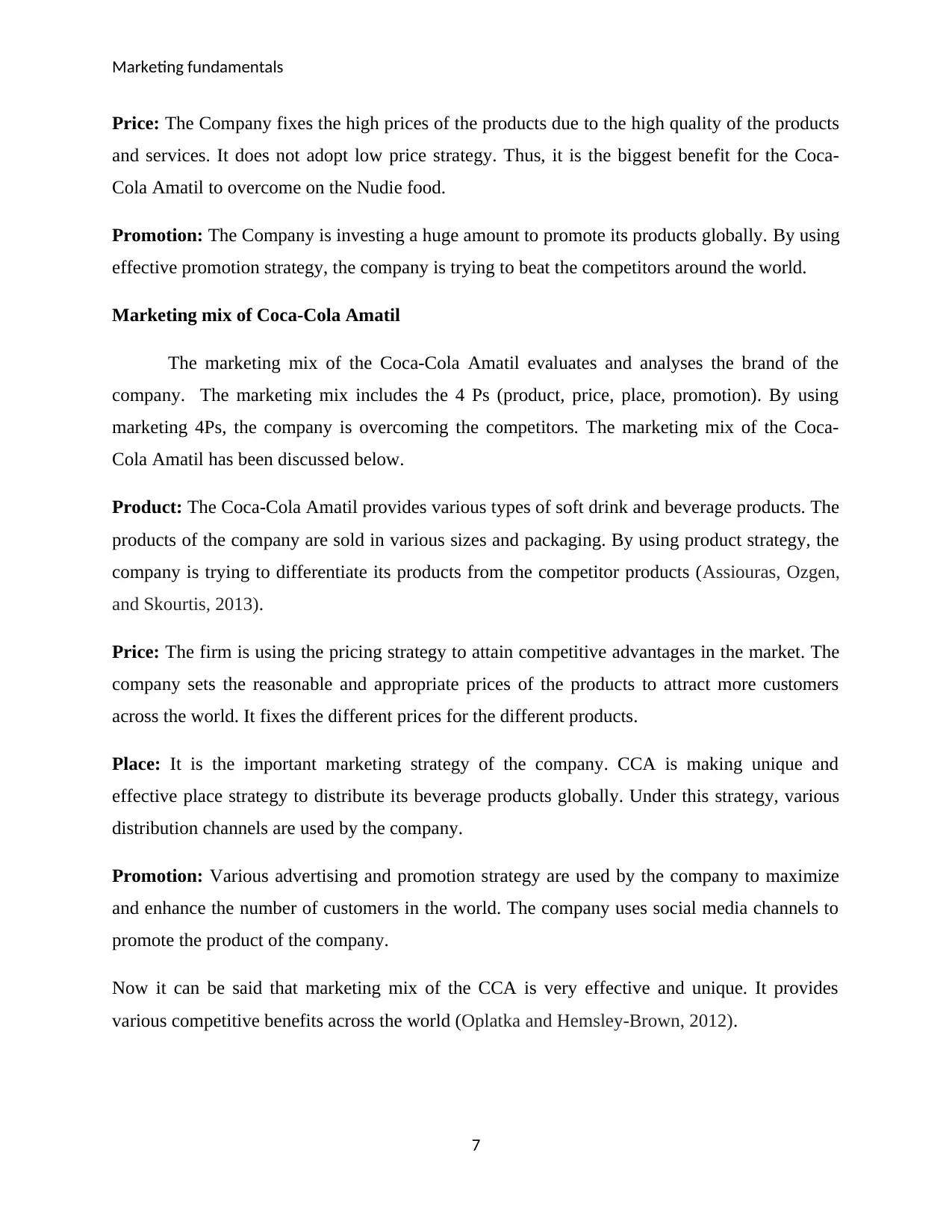
Marketing fundamentals
Price: The Company fixes the high prices of the products due to the high quality of the products
and services. It does not adopt low price strategy. Thus, it is the biggest benefit for the Coca-
Cola Amatil to overcome on the Nudie food.
Promotion: The Company is investing a huge amount to promote its products globally. By using
effective promotion strategy, the company is trying to beat the competitors around the world.
Marketing mix of Coca-Cola Amatil
The marketing mix of the Coca-Cola Amatil evaluates and analyses the brand of the
company. The marketing mix includes the 4 Ps (product, price, place, promotion). By using
marketing 4Ps, the company is overcoming the competitors. The marketing mix of the Coca-
Cola Amatil has been discussed below.
Product: The Coca-Cola Amatil provides various types of soft drink and beverage products. The
products of the company are sold in various sizes and packaging. By using product strategy, the
company is trying to differentiate its products from the competitor products (Assiouras, Ozgen,
and Skourtis, 2013).
Price: The firm is using the pricing strategy to attain competitive advantages in the market. The
company sets the reasonable and appropriate prices of the products to attract more customers
across the world. It fixes the different prices for the different products.
Place: It is the important marketing strategy of the company. CCA is making unique and
effective place strategy to distribute its beverage products globally. Under this strategy, various
distribution channels are used by the company.
Promotion: Various advertising and promotion strategy are used by the company to maximize
and enhance the number of customers in the world. The company uses social media channels to
promote the product of the company.
Now it can be said that marketing mix of the CCA is very effective and unique. It provides
various competitive benefits across the world (Oplatka and Hemsley-Brown, 2012).
7
Price: The Company fixes the high prices of the products due to the high quality of the products
and services. It does not adopt low price strategy. Thus, it is the biggest benefit for the Coca-
Cola Amatil to overcome on the Nudie food.
Promotion: The Company is investing a huge amount to promote its products globally. By using
effective promotion strategy, the company is trying to beat the competitors around the world.
Marketing mix of Coca-Cola Amatil
The marketing mix of the Coca-Cola Amatil evaluates and analyses the brand of the
company. The marketing mix includes the 4 Ps (product, price, place, promotion). By using
marketing 4Ps, the company is overcoming the competitors. The marketing mix of the Coca-
Cola Amatil has been discussed below.
Product: The Coca-Cola Amatil provides various types of soft drink and beverage products. The
products of the company are sold in various sizes and packaging. By using product strategy, the
company is trying to differentiate its products from the competitor products (Assiouras, Ozgen,
and Skourtis, 2013).
Price: The firm is using the pricing strategy to attain competitive advantages in the market. The
company sets the reasonable and appropriate prices of the products to attract more customers
across the world. It fixes the different prices for the different products.
Place: It is the important marketing strategy of the company. CCA is making unique and
effective place strategy to distribute its beverage products globally. Under this strategy, various
distribution channels are used by the company.
Promotion: Various advertising and promotion strategy are used by the company to maximize
and enhance the number of customers in the world. The company uses social media channels to
promote the product of the company.
Now it can be said that marketing mix of the CCA is very effective and unique. It provides
various competitive benefits across the world (Oplatka and Hemsley-Brown, 2012).
7
Paraphrase This Document
Need a fresh take? Get an instant paraphrase of this document with our AI Paraphraser
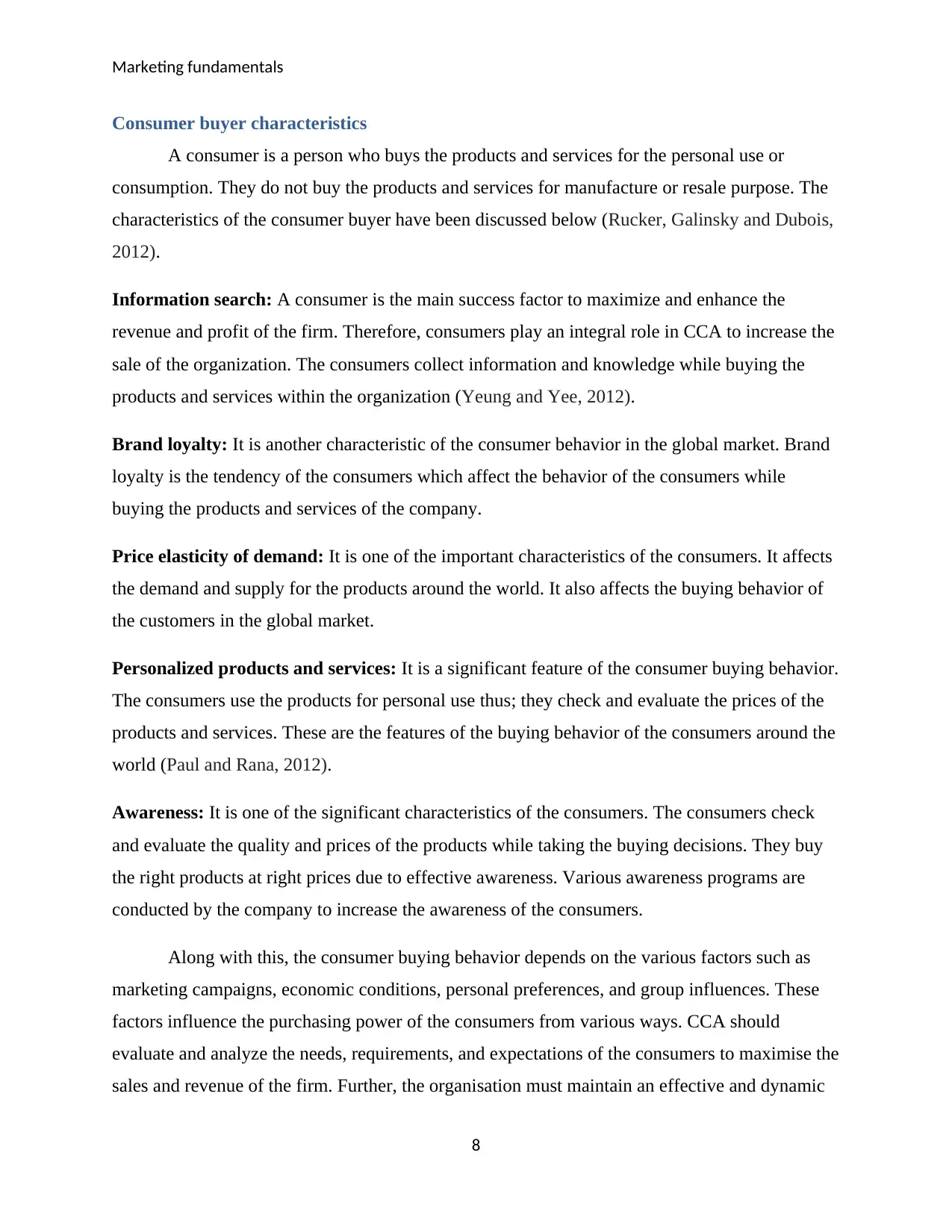
Marketing fundamentals
Consumer buyer characteristics
A consumer is a person who buys the products and services for the personal use or
consumption. They do not buy the products and services for manufacture or resale purpose. The
characteristics of the consumer buyer have been discussed below (Rucker, Galinsky and Dubois,
2012).
Information search: A consumer is the main success factor to maximize and enhance the
revenue and profit of the firm. Therefore, consumers play an integral role in CCA to increase the
sale of the organization. The consumers collect information and knowledge while buying the
products and services within the organization (Yeung and Yee, 2012).
Brand loyalty: It is another characteristic of the consumer behavior in the global market. Brand
loyalty is the tendency of the consumers which affect the behavior of the consumers while
buying the products and services of the company.
Price elasticity of demand: It is one of the important characteristics of the consumers. It affects
the demand and supply for the products around the world. It also affects the buying behavior of
the customers in the global market.
Personalized products and services: It is a significant feature of the consumer buying behavior.
The consumers use the products for personal use thus; they check and evaluate the prices of the
products and services. These are the features of the buying behavior of the consumers around the
world (Paul and Rana, 2012).
Awareness: It is one of the significant characteristics of the consumers. The consumers check
and evaluate the quality and prices of the products while taking the buying decisions. They buy
the right products at right prices due to effective awareness. Various awareness programs are
conducted by the company to increase the awareness of the consumers.
Along with this, the consumer buying behavior depends on the various factors such as
marketing campaigns, economic conditions, personal preferences, and group influences. These
factors influence the purchasing power of the consumers from various ways. CCA should
evaluate and analyze the needs, requirements, and expectations of the consumers to maximise the
sales and revenue of the firm. Further, the organisation must maintain an effective and dynamic
8
Consumer buyer characteristics
A consumer is a person who buys the products and services for the personal use or
consumption. They do not buy the products and services for manufacture or resale purpose. The
characteristics of the consumer buyer have been discussed below (Rucker, Galinsky and Dubois,
2012).
Information search: A consumer is the main success factor to maximize and enhance the
revenue and profit of the firm. Therefore, consumers play an integral role in CCA to increase the
sale of the organization. The consumers collect information and knowledge while buying the
products and services within the organization (Yeung and Yee, 2012).
Brand loyalty: It is another characteristic of the consumer behavior in the global market. Brand
loyalty is the tendency of the consumers which affect the behavior of the consumers while
buying the products and services of the company.
Price elasticity of demand: It is one of the important characteristics of the consumers. It affects
the demand and supply for the products around the world. It also affects the buying behavior of
the customers in the global market.
Personalized products and services: It is a significant feature of the consumer buying behavior.
The consumers use the products for personal use thus; they check and evaluate the prices of the
products and services. These are the features of the buying behavior of the consumers around the
world (Paul and Rana, 2012).
Awareness: It is one of the significant characteristics of the consumers. The consumers check
and evaluate the quality and prices of the products while taking the buying decisions. They buy
the right products at right prices due to effective awareness. Various awareness programs are
conducted by the company to increase the awareness of the consumers.
Along with this, the consumer buying behavior depends on the various factors such as
marketing campaigns, economic conditions, personal preferences, and group influences. These
factors influence the purchasing power of the consumers from various ways. CCA should
evaluate and analyze the needs, requirements, and expectations of the consumers to maximise the
sales and revenue of the firm. Further, the organisation must maintain an effective and dynamic
8

Marketing fundamentals
relationship with consumers across the world. It is the responsibility of the employees that they
provide the right information to the consumers in the market (Reed et al, 2012).
Conclusion
On the above discussion, it has been evaluated that CCA is one of the largest brands in
the world. The company is offering several beverage products to the customers globally. Further,
the firm uses effective and unique strategies to overcome the competitors in the world. PESTEL
analysis, SWOT analysis are done by the organisation to evaluate and analyze the position and
image of the competitors. The company uses marketing mix strategies to differentiate its
products and prices from the competitor products and prices. In this way, the company is able to
gain the competitors advantages in the market. It also helps to accomplish the long-term mission,
objectives and goals of the company. Along with this, the company should focus on the
marketing strategies to reduce the risk and key issues of the global market.
9
relationship with consumers across the world. It is the responsibility of the employees that they
provide the right information to the consumers in the market (Reed et al, 2012).
Conclusion
On the above discussion, it has been evaluated that CCA is one of the largest brands in
the world. The company is offering several beverage products to the customers globally. Further,
the firm uses effective and unique strategies to overcome the competitors in the world. PESTEL
analysis, SWOT analysis are done by the organisation to evaluate and analyze the position and
image of the competitors. The company uses marketing mix strategies to differentiate its
products and prices from the competitor products and prices. In this way, the company is able to
gain the competitors advantages in the market. It also helps to accomplish the long-term mission,
objectives and goals of the company. Along with this, the company should focus on the
marketing strategies to reduce the risk and key issues of the global market.
9
⊘ This is a preview!⊘
Do you want full access?
Subscribe today to unlock all pages.

Trusted by 1+ million students worldwide
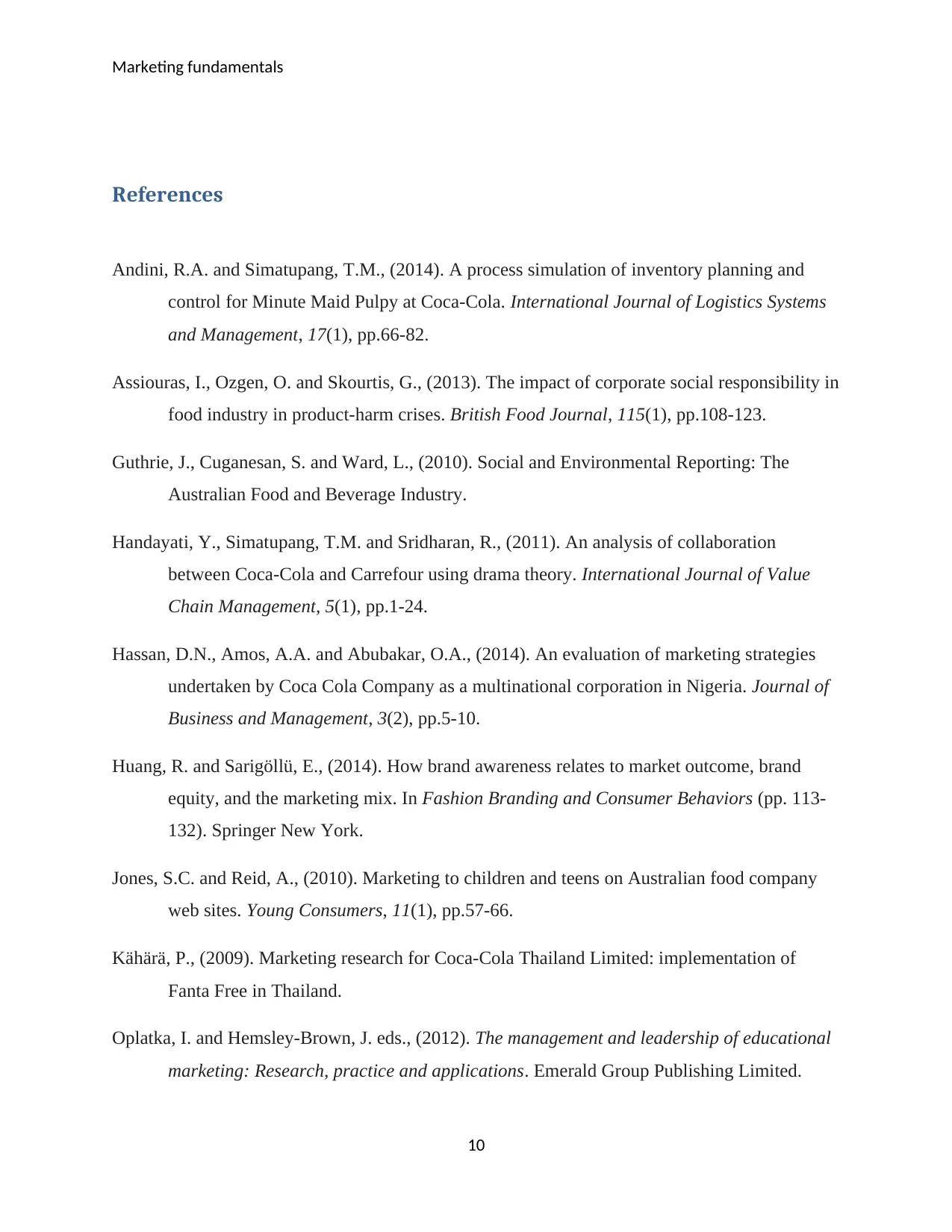
Marketing fundamentals
References
Andini, R.A. and Simatupang, T.M., (2014). A process simulation of inventory planning and
control for Minute Maid Pulpy at Coca-Cola. International Journal of Logistics Systems
and Management, 17(1), pp.66-82.
Assiouras, I., Ozgen, O. and Skourtis, G., (2013). The impact of corporate social responsibility in
food industry in product-harm crises. British Food Journal, 115(1), pp.108-123.
Guthrie, J., Cuganesan, S. and Ward, L., (2010). Social and Environmental Reporting: The
Australian Food and Beverage Industry.
Handayati, Y., Simatupang, T.M. and Sridharan, R., (2011). An analysis of collaboration
between Coca-Cola and Carrefour using drama theory. International Journal of Value
Chain Management, 5(1), pp.1-24.
Hassan, D.N., Amos, A.A. and Abubakar, O.A., (2014). An evaluation of marketing strategies
undertaken by Coca Cola Company as a multinational corporation in Nigeria. Journal of
Business and Management, 3(2), pp.5-10.
Huang, R. and Sarigöllü, E., (2014). How brand awareness relates to market outcome, brand
equity, and the marketing mix. In Fashion Branding and Consumer Behaviors (pp. 113-
132). Springer New York.
Jones, S.C. and Reid, A., (2010). Marketing to children and teens on Australian food company
web sites. Young Consumers, 11(1), pp.57-66.
Kähärä, P., (2009). Marketing research for Coca-Cola Thailand Limited: implementation of
Fanta Free in Thailand.
Oplatka, I. and Hemsley-Brown, J. eds., (2012). The management and leadership of educational
marketing: Research, practice and applications. Emerald Group Publishing Limited.
10
References
Andini, R.A. and Simatupang, T.M., (2014). A process simulation of inventory planning and
control for Minute Maid Pulpy at Coca-Cola. International Journal of Logistics Systems
and Management, 17(1), pp.66-82.
Assiouras, I., Ozgen, O. and Skourtis, G., (2013). The impact of corporate social responsibility in
food industry in product-harm crises. British Food Journal, 115(1), pp.108-123.
Guthrie, J., Cuganesan, S. and Ward, L., (2010). Social and Environmental Reporting: The
Australian Food and Beverage Industry.
Handayati, Y., Simatupang, T.M. and Sridharan, R., (2011). An analysis of collaboration
between Coca-Cola and Carrefour using drama theory. International Journal of Value
Chain Management, 5(1), pp.1-24.
Hassan, D.N., Amos, A.A. and Abubakar, O.A., (2014). An evaluation of marketing strategies
undertaken by Coca Cola Company as a multinational corporation in Nigeria. Journal of
Business and Management, 3(2), pp.5-10.
Huang, R. and Sarigöllü, E., (2014). How brand awareness relates to market outcome, brand
equity, and the marketing mix. In Fashion Branding and Consumer Behaviors (pp. 113-
132). Springer New York.
Jones, S.C. and Reid, A., (2010). Marketing to children and teens on Australian food company
web sites. Young Consumers, 11(1), pp.57-66.
Kähärä, P., (2009). Marketing research for Coca-Cola Thailand Limited: implementation of
Fanta Free in Thailand.
Oplatka, I. and Hemsley-Brown, J. eds., (2012). The management and leadership of educational
marketing: Research, practice and applications. Emerald Group Publishing Limited.
10
Paraphrase This Document
Need a fresh take? Get an instant paraphrase of this document with our AI Paraphraser
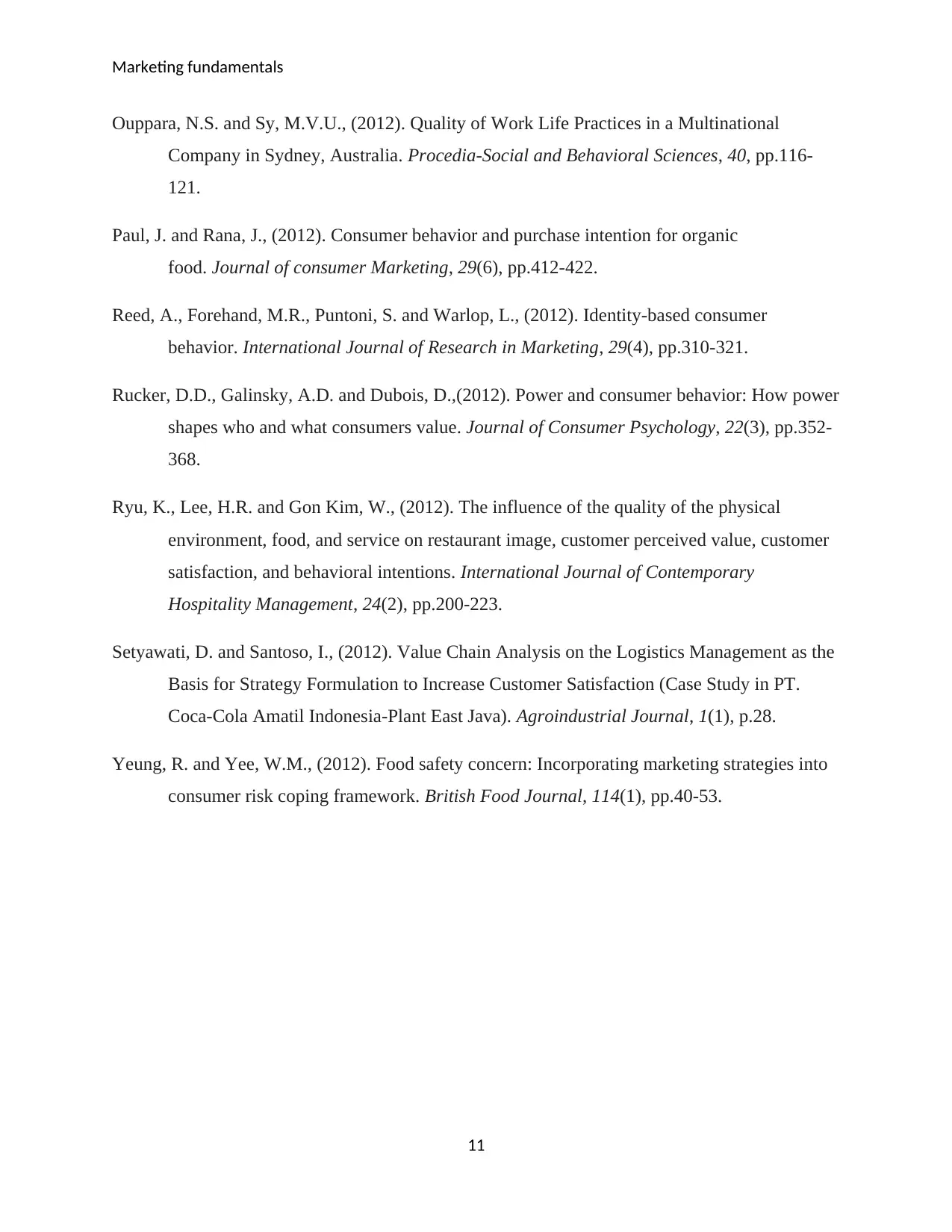
Marketing fundamentals
Ouppara, N.S. and Sy, M.V.U., (2012). Quality of Work Life Practices in a Multinational
Company in Sydney, Australia. Procedia-Social and Behavioral Sciences, 40, pp.116-
121.
Paul, J. and Rana, J., (2012). Consumer behavior and purchase intention for organic
food. Journal of consumer Marketing, 29(6), pp.412-422.
Reed, A., Forehand, M.R., Puntoni, S. and Warlop, L., (2012). Identity-based consumer
behavior. International Journal of Research in Marketing, 29(4), pp.310-321.
Rucker, D.D., Galinsky, A.D. and Dubois, D.,(2012). Power and consumer behavior: How power
shapes who and what consumers value. Journal of Consumer Psychology, 22(3), pp.352-
368.
Ryu, K., Lee, H.R. and Gon Kim, W., (2012). The influence of the quality of the physical
environment, food, and service on restaurant image, customer perceived value, customer
satisfaction, and behavioral intentions. International Journal of Contemporary
Hospitality Management, 24(2), pp.200-223.
Setyawati, D. and Santoso, I., (2012). Value Chain Analysis on the Logistics Management as the
Basis for Strategy Formulation to Increase Customer Satisfaction (Case Study in PT.
Coca-Cola Amatil Indonesia-Plant East Java). Agroindustrial Journal, 1(1), p.28.
Yeung, R. and Yee, W.M., (2012). Food safety concern: Incorporating marketing strategies into
consumer risk coping framework. British Food Journal, 114(1), pp.40-53.
11
Ouppara, N.S. and Sy, M.V.U., (2012). Quality of Work Life Practices in a Multinational
Company in Sydney, Australia. Procedia-Social and Behavioral Sciences, 40, pp.116-
121.
Paul, J. and Rana, J., (2012). Consumer behavior and purchase intention for organic
food. Journal of consumer Marketing, 29(6), pp.412-422.
Reed, A., Forehand, M.R., Puntoni, S. and Warlop, L., (2012). Identity-based consumer
behavior. International Journal of Research in Marketing, 29(4), pp.310-321.
Rucker, D.D., Galinsky, A.D. and Dubois, D.,(2012). Power and consumer behavior: How power
shapes who and what consumers value. Journal of Consumer Psychology, 22(3), pp.352-
368.
Ryu, K., Lee, H.R. and Gon Kim, W., (2012). The influence of the quality of the physical
environment, food, and service on restaurant image, customer perceived value, customer
satisfaction, and behavioral intentions. International Journal of Contemporary
Hospitality Management, 24(2), pp.200-223.
Setyawati, D. and Santoso, I., (2012). Value Chain Analysis on the Logistics Management as the
Basis for Strategy Formulation to Increase Customer Satisfaction (Case Study in PT.
Coca-Cola Amatil Indonesia-Plant East Java). Agroindustrial Journal, 1(1), p.28.
Yeung, R. and Yee, W.M., (2012). Food safety concern: Incorporating marketing strategies into
consumer risk coping framework. British Food Journal, 114(1), pp.40-53.
11
1 out of 11
Related Documents
Your All-in-One AI-Powered Toolkit for Academic Success.
+13062052269
info@desklib.com
Available 24*7 on WhatsApp / Email
![[object Object]](/_next/static/media/star-bottom.7253800d.svg)
Unlock your academic potential
Copyright © 2020–2025 A2Z Services. All Rights Reserved. Developed and managed by ZUCOL.





